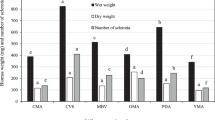Abstract
Evaluation of four different methods of artificial inoculation viz., syringe and spindle inoculation, detached leaf assay and sett dip methods indicated that the syringe method was the most suitable followed by spindle inoculation for evaluation of sugarcane varieties against pokkah boeng disease under controlled conditions. However, the preliminary assessment of the resistance of 88 sugarcane germplasm lines against two most prevalent fungal species associated with pokkah boeng disease, F. verticillioides CNO-1 and F. proliferatum YN-41, by spindle inoculation method indicated that the CNO-1 was more virulent. Furthermore, our study identified GT11, GT37, NCO310, POJ2878, and F134 as highly susceptible, whereas CP84-1198, GT05-3846, ROC27, and YT94-128 as highly resistant clones. Spindle inoculation method was found as the most reliable method of inoculation of young sugarcane germplasm under indoor condition for screening resistance against pokkah boeng disease.


Similar content being viewed by others
References
Aoki, T., K. O’Donnell, and D.M. Geiser. 2014. Systematics of key phytopathogenic Fusarium species: Current status and future challenges. Journal of General Plant Pathalogy 80(3): 189–201.
Appunu, C., and M.N. Premachandran. 2012. Choice of parental clones in sugarcane breeding programme at Coimbatore in evolving Co canes—A retrospection. In Proceedings of the international symposium on new paradigms in sugarcane research, ed. R. Viswanathan, G. Hemaprabha, A. Bhaskaran, K. Mohanraj, V. Jayakumar, T. Ramasubramanian, and N.V. Nair, 11–12. Coimbatore: Sugarcane Breeding Institute.
Balamuralikrishna, M., D. Sabitha, T. Ganapathy, and R. Viswanathan. 2003. Sugarcane mosaic virus infection progress in relation to age of sugarcane. Sugar Tech 5(1&2): 21–24.
Chen, R.K., L.P. Xu, and Y.Q. Lin. 2011. Modern sugarcane genetic breeding. Beijing: China Agriculture Press.
Gazaffi, R., K.M. Oliveira, A.P. Souza, and A.A.F. Garia. 2010. The importance of the germplasm in developing agro-energetic profile sugarcane cultivars. In Sugar Cane Bioethanol: R&D for productivity and sustainability, ed. L.A.B. Cortez, 333–343. Sao Paulo: Blucher.
Govender, P., S.A. McFarlane, and R. Rutherford. 2010. Fusarium species causing pokkah boeng and their effect on Eldana saccharina Walker (lepidoptera: pyralidae). Proceedings of the South African Sugar Technology Association 83:267–270.
Hapase, R.S. 2012. Breeding strategies for improving productivity and diseases resistance. In Sugarcane breeders and pathologist meet, ed. N.V. Nair, R. Viswanathan, P. Govindaraj, and K. Mohanraj, 86–87. Sugarcane Breeding Institute: Coimbatore.
Khani, K.T., A. Alizadeh, R.F. Nejad, and A.S Tehrani. 2013. Pathogenicity of Fusarium proliferatum, a new causal agent of pokkah boeng in sugarcane. Proceedings of the International Society Sugarcane Technology 23: 1–5.
Li, Y.R. 2003. Discussion about the sugarcane sugar industry development in Guangxi after China’s entry into WTO. Guangxi Agricultural Sciences 1: 1–4.
Li, Y.R. 2005. Springing up of sugarcane and sugar industry in China. Guangxi Agricultural Sciences 36(1): 79–81.
Lyrene, P.M., J.L. Dean, and N.I. James. 1977. Inheritance of resistance to pokkah boeng in sugarcane crosses. Phytopathology 67: 689–692.
Lin, Z.Y., S.Q. Xu, Y.X. Que, J.H. Wang, and J.C. Comstock. 2014. Species-specific detection and identification of Fusarium species complex, the causal agent of sugarcane pokkah boeng in China. PLoS ONE 9(8): e104195. doi:10.1371/journal.pone.0104195.
Martin, J.P., H. Handojo, and C. Wismer. 1989. Pokkah Boeng-diseases of sugarcane. Diseases of Sugarcane xi: 157–168.
McFarlane, S.A., and R. Rutherford. 2005. Fusarium species isolated from sugarcane in KwaZulu-Natal and their effect on Eldana saccharina (Lepidoptera: Pyralidae) development in vitro. In Proceedings of the 79th annual congress of South African Sugar Technologists’ Association, held at Kwa-Shukela, Mount Edgecombe, South Africa, 19–22 July 2005.
Olweny, C., N. Kahiu, H. Nzioki, and S.M. Githiri. 2008. Evaluation of smut inoculation techniques in sugarcane seedlings. Sugar Tech 10(4): 341–345.
Patil, A.S. 1995. Studies on pokkah boeng and pine apple disease of sugarcane in Maharashtra with their economic losses in yield and quality of sugarcane. Final Project Report. Pune: ICAR, VSI.
Prom, L.K., B.J. Steffenson, B. Salas, J. Mos, Fetch, T.G. Jr, and H.H. Casper. 1996. Evaluation of selected barley accessions for resistance to Fusarium head blight and deoxynivalenol concentration. In G. Scoles and B. Rossnagel (ed.) Proceedings of the Fifth Internatinal Oat Conference and VII International Barley Symposium, 764–766. Saskatoon, Canada. 30 July–6 August 1996.
Rao, J.T. 1989. Sugarcane Origin, Taxonomy, Breeding and Varieties. In Sugarcane varietal improvement, ed. K.M. Naidu, T.V. Sreenivasan, and M.N. Premachandran, 83–113. Coimbatore: Sugarcane Breeding Institute.
Singh, R.K., M.S. Khan, R. Singh, D.K. Pandey, S. Kumar, and S. Lal. 2011. Analysis of genetic differentiation and phylogenetic relationships among sugarcane genotypes differing in response to red rot. Sugar Tech 13(2): 137–144.
Singh, A., S.S. Chauhan, A. Singh, and S.B. Singh. 2006. Deterioration in sugarcane due to pokkah boeng disease. Sugar Tech 8: 187–190.
Siddique, S. 2007. Pathogenicity and aethiology of Fusarium species associated with pokkah boeng disease on sugarcane. Thesis, University of Malaysia, Malaysia.
Vishwakarma, S., P. Kumar, A. Nigam, A. Singh, and A. Kumar. 2013. Pokkah boeng: an emerging disease of sugarcane. Journal of Plant Pathology and Microbiology 4: 170. doi:10.4172/2157-7471.1000170.
Whittle, P., and L. Irawan. 2000. Pokkah boeng. In A guide to sugarcane diseases, ed. P. Rott, R.A. Bailey, J.C. Comstock, B.J. Croft, and A.S. Saumtally, 136–140. Montpellier: CIRAD and ISSCT.
Wang, Z.P., W.X. Duan, Y.J. Li, Q. Liang, Z.G. Zhou, M.Q. Zhang, and S.H. Lin. 2016. Establishment of resistance evaluation system in the field for sugarcane pokkah boeng. Journal of South China Agricultural University 37(3): 67–72.
Author information
Authors and Affiliations
Corresponding author
Rights and permissions
About this article
Cite this article
Wang, ZP., Sun, HJ., Guo, Q. et al. Artificial Inoculation Method of Pokkah Boeng Disease of Sugarcane and Screening of Resistant Germplasm Resources in Subtropical China. Sugar Tech 19, 283–292 (2017). https://doi.org/10.1007/s12355-016-0465-7
Received:
Accepted:
Published:
Issue Date:
DOI: https://doi.org/10.1007/s12355-016-0465-7




